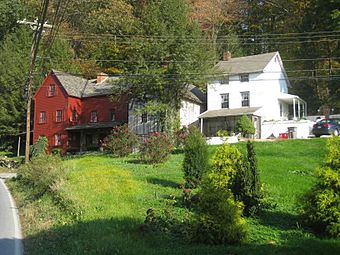Embreeville Historic District facts for kids
Quick facts for kids |
|
|
Embreeville Historic District
|
|

Embreeville Historic District, October 2011
|
|
| Location | Rt. 162, Newlin Township, Pennsylvania |
|---|---|
| Area | 65 acres (26 ha) |
| Architect | Multiple |
| MPS | West Branch Brandywine Creek MRA |
| NRHP reference No. | 85002350 |
| Added to NRHP | September 16, 1985 |
The Embreeville Historic District is a special place in Newlin Township, Chester County, Pennsylvania. It's called a historic district because it has many old and important buildings. These buildings help us understand what life was like a long time ago.
This district includes 12 important buildings. They are located along the east and west sides of the West Branch Brandywine Creek. Most of these buildings were built between 1822 and 1842. However, the oldest house dates back to about 1760!
Contents
What is a Historic District?
A historic district is an area that has a group of buildings, structures, or objects that are important to history. These places are often protected. This means they cannot be torn down or changed too much. They are kept safe so future generations can learn from them.
The Embreeville Historic District was added to the National Register of Historic Places in 1985. This is a list of places in the United States that are important for their history, architecture, or culture. Being on this list helps protect these special sites.
Exploring Embreeville's Historic Buildings
The buildings in Embreeville Historic District are made of stone. Many are covered with stucco, which is a type of plaster. They show a style of building that was common a long time ago. Each building tells a part of the story of this old village.
Homes and Shops
The district includes several homes and businesses. There's an old farmhouse where a family likely lived and worked the land. You can also find a country store. This store was probably the main place for people to buy supplies. The storekeeper's house is also part of the district.
Craftsmen's Workshops
Other buildings show where skilled workers practiced their trades. There was a blacksmith's house. A blacksmith made and repaired things out of metal, like tools and horseshoes. There was also a wheelwright's house and store. A wheelwright built and fixed wooden wheels for wagons and carts. These jobs were very important before cars and factories existed.
The Embreeville Mill
One of the most important buildings is the grist mill. It is known as the Embreeville Mill. A grist mill was a place where farmers brought their grains, like corn or wheat, to be ground into flour. This mill would have been a busy place, powered by the creek's water. The miller's house, where the person who ran the mill lived, is also part of the district.
The "Mansion"
There is also a larger house built in 1856, sometimes called a "mansion." This might have been the home of a wealthy family or an important person in the community. It shows how the village grew and changed over time.
Life in Embreeville Long Ago
Imagine what life was like in Embreeville in the 1800s. People would wake up early to work on their farms or in their shops. The sound of the mill grinding grain would fill the air. The blacksmith's hammer would clang. Neighbors would visit the country store to chat and buy what they needed. The creek was a vital part of life, providing water for the mill and perhaps for fishing.
This historic district helps us step back in time. It shows us how people lived, worked, and built their communities many years ago in Pennsylvania.
Gallery





